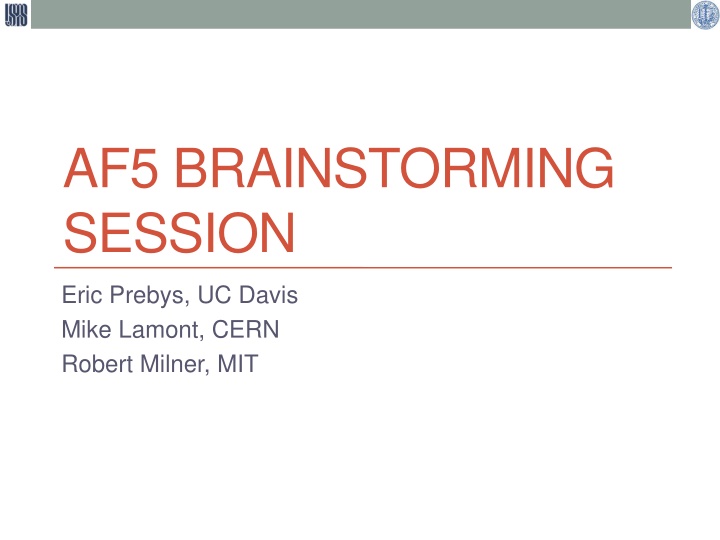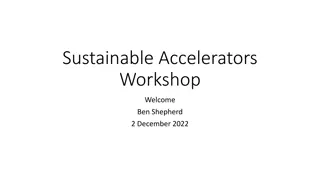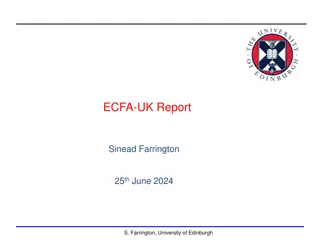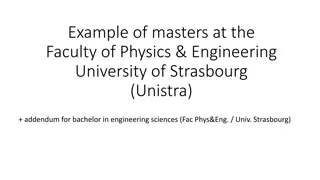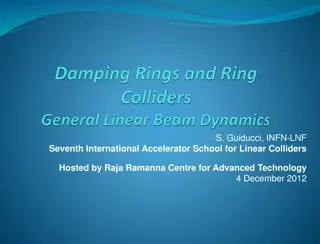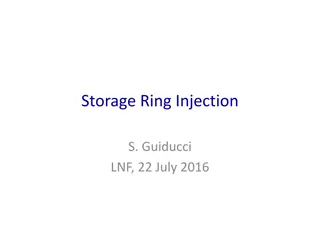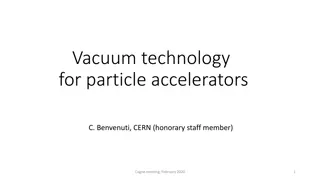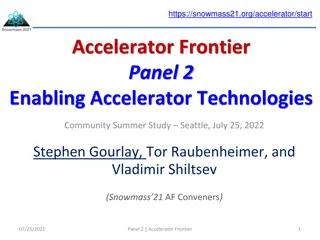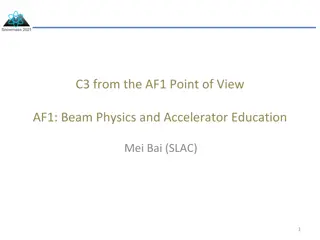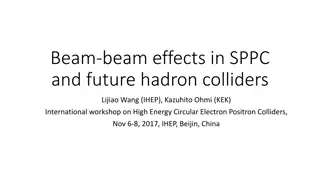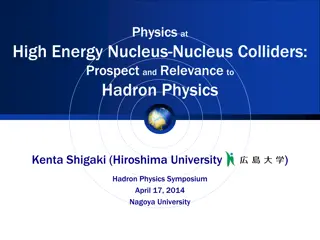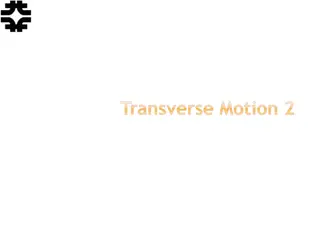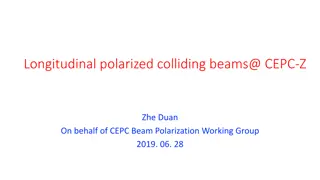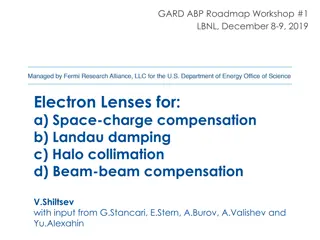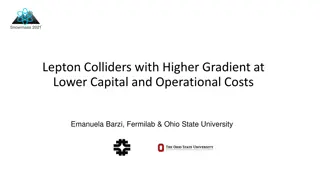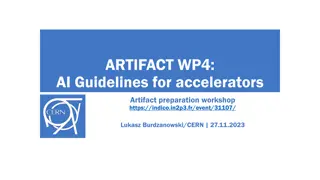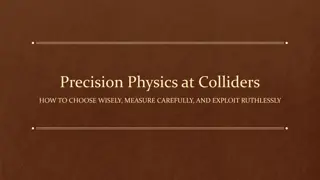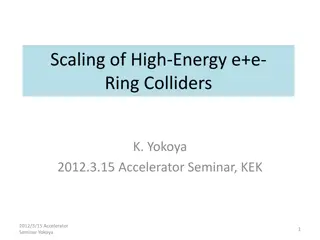Accelerators for Physics Beyond Colliders
A brainstorming session focusing on exploring rare processes and Physics Beyond Colliders (PBC). Discussions include modifications of existing accelerators, future scientific infrastructure, and collaborations worldwide. Topics cover hidden sector searches, light dark matter searches, and strategies for organizing Letters of Intent (LoIs) in the field. The session aims to solicit new topics, suggest US contacts, and address diverse frontiers in high-energy physics.
Download Presentation

Please find below an Image/Link to download the presentation.
The content on the website is provided AS IS for your information and personal use only. It may not be sold, licensed, or shared on other websites without obtaining consent from the author.If you encounter any issues during the download, it is possible that the publisher has removed the file from their server.
You are allowed to download the files provided on this website for personal or commercial use, subject to the condition that they are used lawfully. All files are the property of their respective owners.
The content on the website is provided AS IS for your information and personal use only. It may not be sold, licensed, or shared on other websites without obtaining consent from the author.
E N D
Presentation Transcript
AF5 BRAINSTORMING SESSION Eric Prebys, UC Davis Mike Lamont, CERN Robert Milner, MIT
EF/RP/AF Cross-Frontier Meeting, 6/22/2020 2 E. Prebys, AF5 AF5: Accelerators for PBC and Rare Processes Description: A number of fundamental physics questions require exploration of rare processes and what is called Physics Beyond Colliders (PBC). These are similar in spirit to those addressed by high-energy colliders, but require different types of beams and experiments. Modifications of existing accelerator complexes and future dedicated scientific infrastructure are considered for the next two decades through projects complementary to the LHC/HL-LHC and other possible future colliders. This efffort has greatly benefitted from the The Physics Beyond Collider study at CERN was set-up in 2016 and reported to the European Strategy for Particle Physics in 2019. Although it naturally had a CERN/European bent, it did attempt to evaluate things in a worldwide context. A couple of potentially interesting references follow. Beyond the Standard Model Working Group Report https://arxiv.org/abs/1901.09966 Summary Report of Physics Beyond Colliders at CERN https://arxiv.org/abs/1902.00260
EF/RP/AF Cross-Frontier Meeting, 6/22/2020 3 E. Prebys, AF5 Goals of this Meeting Solicit additional topics for our focus area Solicit suggestions for US contacts for some of the more Eurocentric areas Discuss the best way to organize LoIs in this are, given then it s inextricably linked to several other frontiers and focus areas.
EF/RP/AF Cross-Frontier Meeting, 6/22/2020 4 E. Prebys, AF5 Low energy hidden sector searches Motivated by the QCD axion as well as astrophysical hints, the low energy hidden sector is potentially accessible via number of sub-eV Axion/ALP search techniques. For example: Helioscopes (e.g. BabyIAXO/IAXO) Haloscopes using resonant cavities (e.g. ADMX) or other methods (e.g. MADMAX) Light-shining-through-walls experiments (e.g. JURA, STAX) Many of these initiatives can profit from ongoing advances in accelerator technology e.g. high field superconducting magnets, superconducting RF.
EF/RP/AF Cross-Frontier Meeting, 6/22/2020 5 E. Prebys, AF5 Light Dark Matter searches Light Dark Matter searches in the MeV - GeV mass range target a parameter space of the Hidden Sector of special relevance to open questions in cosmology. Options include: Direct detection WIMP searches (primarily addressed by the Cosmic Frontier). Proton beam dump experiment: new proposals (e.g. BDF/SHiP), re-purposed existing experiments (e.g. NA62, MiniBooNE, SeaQuest) Electron beam dump experiments: NA64, LDMX, BDX Proposals could include use of novel use of existing facilities (LCLS-II, CEBAF, FAST/IOTA) or the development of new facilities. Long lived particles at colliders (LHC, SuperKEKB)
EF/RP/AF Cross-Frontier Meeting, 6/22/2020 6 E. Prebys, AF5 Precision measurements and rare decays Precision measurements and rare decays can probe higher masses than accessible with LHC direct searches, via searches for the possible influence of the contribution of loop diagrams in a number of scenarios. For example: Ultra-rare or forbidden decays/reactions: Kaon sector (NA62, KOTO, KLEVER} Lepton sector (TauFV, Mu3e, MEG,mu2e/mu2e-II) Precision measurements: Permanent EDM in protons/deuterons (CPEDM) in strange/charmed baryons (LHC-FT) Anomalous magnetic moment of muon (g-2)
EF/RP/AF Cross-Frontier Meeting, 6/22/2020 7 E. Prebys, AF5 Technologies Use of existing accelerator technologies or accelerator technology under development for novel physics applications Technologies to be considered include: High field magnets e.g. axion and dark matter searches Superconducting RF e.g. axion searches ERLs Induction LINACs e.g. rare muon processes Quantum sensors, ultra-sensitive opto-mechanical force sensors (e.g. KWISP) Carbon Nanotubes (CNT) (e.g. directional detection of DM candidates) Physics applications might include various types of axion/ALP searches (mentioned above), vacuum magnetic birefringence (VMB), exploration of Ultra-Light Dark Matter and Mid- Frequency Gravitational Waves (e.g. AION, MAGIS)
EF/RP/AF Cross-Frontier Meeting, 6/22/2020 8 E. Prebys, AF5 Specific Organizational Question Where does AF5 fit into the overall scheme of things? Do we advocate for particular technologies that will benefit experiments, or do with join forces with particular experimental LoIs? How do we avoid duplicated effort with other groups IMHO, we should identify specific accelerator and accelerator-related technologies that benefit one or more experimental areas. Beam intensity/bunch structure Esp. as it relates to PIP-II Targetry for electron and proton beam dump experiments Magnet and RF technology for dark sector experiments Novel storage rings: g-2, EDM, etc Facilitating accelerator technology, particularly for muons: induction linacs, FFAGs, etc Do beta beams fall under us or neutrino?
